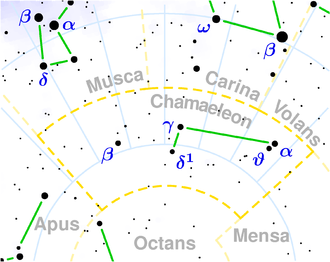NGC 2915
| Galaxy NGC 2915 |
|
|---|---|

|
|
| The galaxy NGC 2915 imaged by the Hubble Space Telescope . | |
| AladinLite | |
| Constellation | chameleon |
|
Position equinox : J2000.0 , epoch : J2000.0 |
|
| Right ascension | 09 h 26 m 11.5 s |
| declination | -76 ° 37 ′ 35 ″ |
| Appearance | |
| Morphological type | I0 / HII |
| Brightness (visual) | 12.3 mag |
| Brightness (B-band) | 13.2 mag |
| Angular expansion | 1.9 ′ × 0.9 ′ |
| Position angle | 129 ° |
| Surface brightness | 12.7 mag / arcmin² |
| Physical data | |
| Redshift | 0.001561 ± 0.000010 |
| Radial velocity | 468 ± 3 km / s |
|
Stroke distance v rad / H 0 |
(12 ± 1) x 10 6 ly (3.63 ± 0.28) Mpc |
| history | |
| discovery | John Herschel |
| Discovery date | March 31, 1837 |
| Catalog names | |
| NGC 2915 • PGC 26761 • ESO 037-003 • IRAS 09265-7624 • 2MASX J09261153-7637347 • SGC 092631-7624.5 • GC 1871 • h 3174 • HIPASS J0926-76 | |
NGC 2915 is an irregular galaxy with extensive star formation areas in the constellation Chameleon in the southern sky . It is estimated to be 12 million light-years from the Milky Way and about 15,000 light-years across. The visible area of the galaxy is surrounded by a much larger spiral structure made of non- ionized hydrogen , as recordings in the radio range show.
The object was discovered on March 31, 1837 by the British astronomer John Herschel .
Web links
Commons : NGC 2915 - Album containing pictures, videos and audio files
